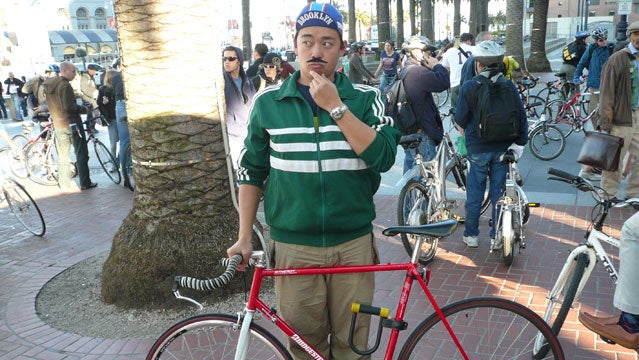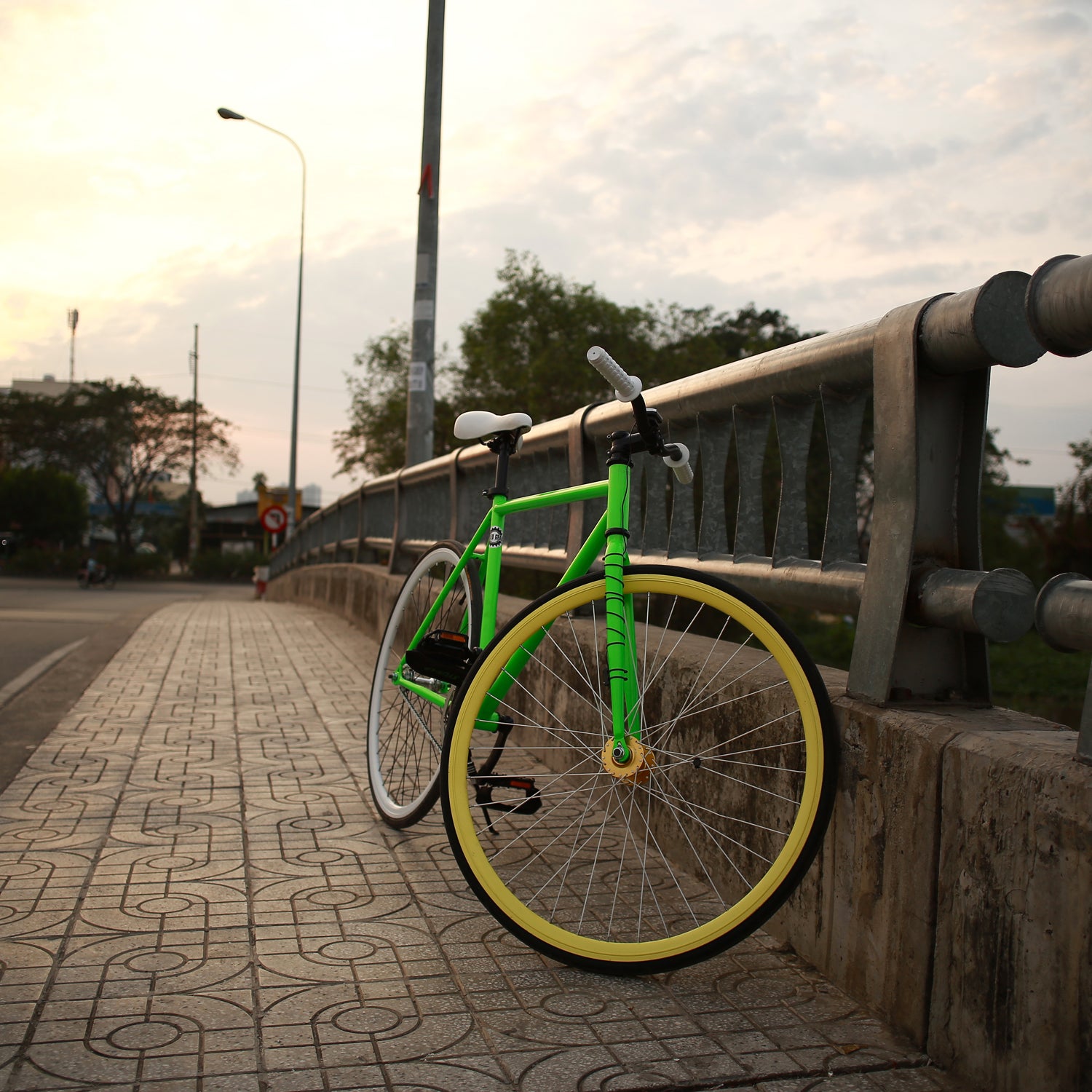A fixie��is a bike without a freewheel—think: no coasting—that's often ridden without brakes. It's a simple concept that provokes some serious emotion in the cycling world: Bikers either love fixies or loathe them. To help you decide which side you're on, we start here with an ode to the fixie written by Stephen Regenold, editor and founder of . Read on for an anti-fixie screed from ���ϳԹ��� Online's editor, Scott Rosenfield, an avid cyclist who's not a fan of the hipster's favored ride.
In Praise of Fixies
The first time I rode a fixie, in 2006, it nearly killed me. My legs locked in motion with the wheels, I built some speed to crest a rise.
On top, I gazed ahead down the hill, and started to descend. In an old habit I stopped pedaling and attempted to coast. Bad move. My cranks bucked sharply and the bike swerved, the pedals forcing my feet in circles as the frame cut air on the steep downhill.
The machine was alive! This horse wanted to run, and I wasn’t about to stop it. I felt a rush, the intoxication of riding on the back of something wild, a little dangerous and, most of all just plain fast and fun.
I haven't quit since.
The fixed-gear experience is like nothing else on two wheels. It's a special feeling, an “almost mystical connection,” as bicycle mechanic/muse Sheldon Brown puts it in his well-read ““
Brown, who died in 2008, was no hipster. He was an old guy with a beard who rode regular and fixed-gear bikes, the latter of which he noted feel “like an extension of your body to a greater extent than does a freewheel-equipped machine.”
I go further: Freewheel-equipped bikes, to me, feel broken and limp compared to fixed-gear. By stripping a bike down to its basic design—ditching the freewheel, gears, and sometimes even the brake—you gain ultimate control.
Your body and your riding technique stand in for the missing parts. Your legs are your gas and your brakes. You spin hard for speed, and resist the motion of the rotating cranks when you need to slow down. When you get tired, you can’t coast or shift to an easier gear.
Skeptics see fixed-gear bikes as antiquated or dangerous. Freewheels, gears, and (especially) brakes have become standard for a reason, right?
To be sure, getting a fixie is a bad idea for many riders. Most people benefit from gears and the ability to coast while riding on long tours or commuting in cities with lots of hills. Riding a fixed-gear takes time to get used to. It’s also not for the out-of-shape, and if you have bad knees, riding fixed may make them worse.
But Telemark skiing might hurt your knees, too. Telemark is also harder than alpine. Or how about running in minimalist shoes? Some people are injured, but others gain strength, speed, and (yes) “connection” with the ground by stripping the design down to its essentials.
As for brakes, most fixed-gear riders I know have one on the front wheel. But you can ride without brakes once you're used to the machine. Putting back-pressure on spinning cranks slows you effectively, just like a brake handle can. If you need to stop faster, you can skid to a halt by taking some weight off the rear wheel and locking your legs.
After six years of using them, I ditched my brakes in 2012. I almost never used them, only touching the hand brake when I was tired and didn’t feel like putting back-pressure on the cranks. It’s hard to explain why, but for me, riding without conventional brakes puts me more in sync with the road and my surroundings. I certainly don’t recommend that everyone rush to their garage and remove their brakes (riding brakeless takes a ton of practice, and is illegal in some places). But despite what freewheelers think, stopping without them is rarely dramatic or dangerous.
My current fixie is built off a scandium frame from boutique of L.A., and leans toward a track-bike design. At about 16 pounds and with a gearing of 48 x 16, it’s a remarkably versatile bike, a demon of a build that can leap from a standstill to 25 miles per hour like a drag racer and alongside my geared buddies for 30 or 50 miles on city rides or country roads.
During the snowy months here in Minneapolis, I commute on a winterized fixie with a mountain-bike frame and studded tires. The extra traction and “road feel” of the fixed gearing has won me over after years of riding through snow on freewheel-equipped bikes.
Fixies excel as training tools, too. As an endurance athlete and a serious runner, I like to say that riding a fixed-gear is like “running on a bike.” Without a freewheel, you are always working. I sweat more and try harder, pushing a big gear on hills with no other way to get up, then spinning fast or resisting the pedal force as gravity again takes hold on the descent.
In the end, fixie haters are gonna hate. Be it the brake debate or the hipster embrace, dissing the “fixed culture” is a popular thing to do. But fixed-gear is not a trend to me. I've been enthralled for years, ever since that bike tried to buck me off in 2006. I got back on the horse, and I haven't let go since.
—Stephen Regenold
Why Fixies Belong in the Garbage
��

I’ll admit it: Fixies do have a certain appeal. They’re simple, aesthetically pleasing, and—in a very particular setting, like on the velodrome or in the trash—even functional. But 99 percent of the time, there’s a better tool for the job.
Hating on fixed-gear bikes is almost too easy. At their finest, bikes are efficient, safe, and eminently enjoyable means of transportation. However, strip away a couple key components—namely the brakes and freewheel—and they become dangerous and impractical.
Anyone who’s ridden a bike knows that drivers can be unpredictable. Even the calmest of on-road commutes invariably involves a fair bit of swerving and emergency braking. Cyclists absolutely need to be able to stop as quickly as possible, and the stopping distance of a fixie is reportedly twice that of a front-brake-equipped bike—in the best of cases.
Fixed-gear nuts will tell you that an inexperienced rider is more likely to flip over his bars emergency braking on a road bike than on a fixie. As someone who’s raced on the track and road, it’s far more intuitive to stop safely using two brakes than by backpedalling. You’re also less likely to burn through costly rubber trying to skid to a stop.
True, some riders add front brakes to their fixies, which makes them a little more practical (and, depending on where you live, legal). But if brakes add a level of sanity, they also adulterate the machine. Taking a bike which is essentially a style statement—a direct insult to conformity and functionality—and trying to make it practical seems self-defeating, almost like purchasing a hybrid Hummer. Sure, it’s better than riding without brakes, but is it really the best option?
Even on the flattest of terrain, the majority of people would benefit from gearing or the ability to coast, something the fixie cannot afford its riders. The majority of amateur fixie riders end up over-geared and struggling to get up to speed from stops, or under-geared and furiously pedaling on the slightest downhills.
Fixie proponents claim that struggling with your machines forces riders to become more efficient—that your legs adapt to producing power over a range of cadences. Science says that argument is entirely irrelevant; the fastest riders actually have some of chunkiest pedal strokes, as . And pulling up on the pedals actually reduces your efficiency, .
Then there’s the matter of fixies’ supposedly superior road feel. The idea is that by stripping a bike of its functionality, you gain a higher degree of control. But control is about getting the most out of your body and bike, not making the most of a faulty machine. For me, that means accelerating effortlessly and having the optimal gearing for any situation. Just imagine an F1 driver telling you that he’s upgrading his car to something with marginally-functional brakes and one gear to feel more connected to the road.
And as much as I’ve tried to avoid hating on hipsters, fixies don’t just ride themselves. There’s a certain category of person who consciously chooses to eschew brakes, gears, and sensibility in their bikes, and all too often, that person is also into PBR, Converse, and excessive irony. Some say it’s a “suicidal response to urban conditioning,” an act of rebellion against conformity. But when a subversive act becomes a trend, against what, exactly, is it rebelling?
The fixie is meant for the velodrome, and it excels there. Taken anywhere else, it’s nothing more than a borderline-nonfunctional cliche. If you plan to ride on the road, gears are the way to go.
—Scott Rosenfield


